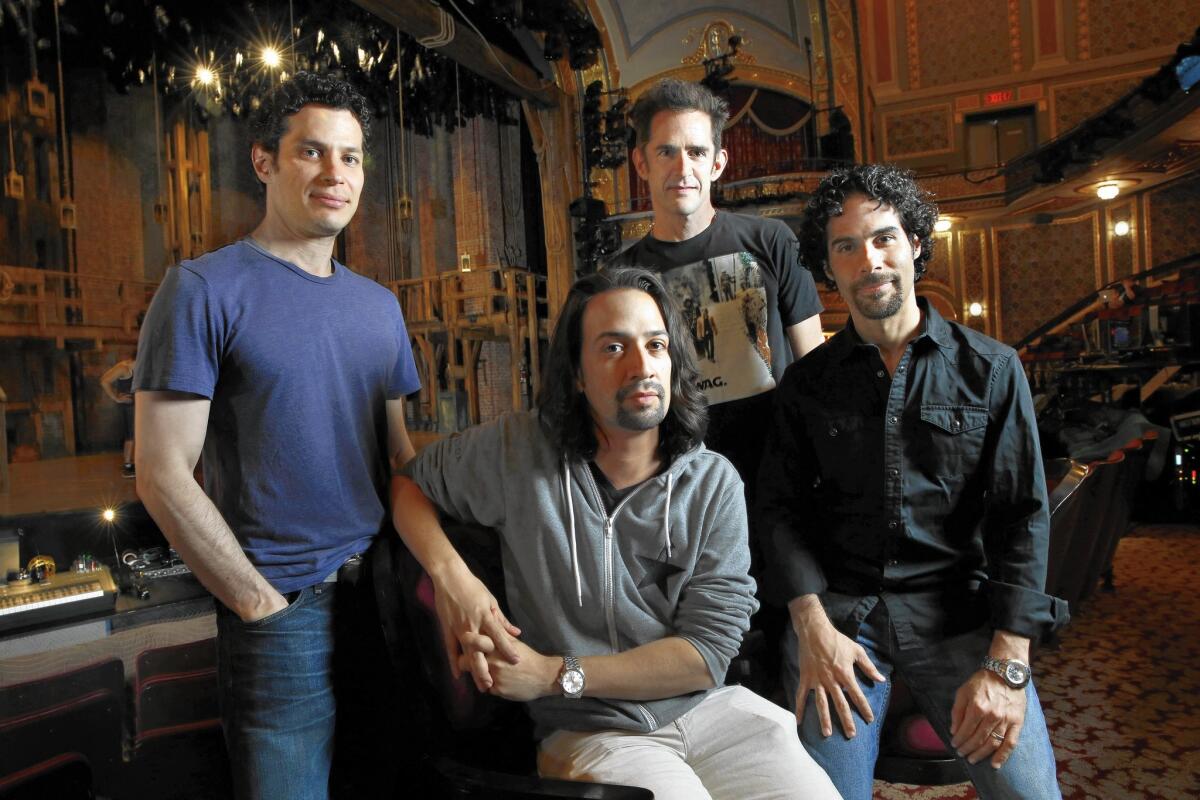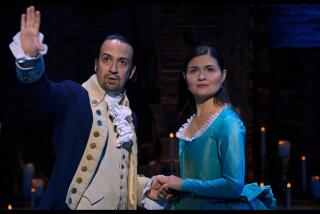‘Hamilton’ offers American history with a hip-hop beat

NEW YORK — More than a few students over the years have wished they were listening to hip-hop instead of learning about American history.
Merging rap and the nation’s origins, then, might seem as improbable as the image of Biggie on the $100 bill.
Yet Tony award winner Lin-Manuel Miranda has been scoffing at the probable for most of his young career. With his new musical, “Hamilton,” the writer-actor gives it the full-on cold shoulder, setting a tale of Alexander Hamilton and Revolutionary War-era America against beats and rhymes.
“When I first heard the story of Hamilton’s life, I thought, ‘A lot of this out-Dickens Dickens,’” said Miranda, 35, who wrote the show’s book, music and lyrics and plays the title character. “I also thought, ‘This is like the great hip-hop narratives.’ It really didn’t take much teasing out.”
Miranda is in the balcony of Broadway’s Richard Rodgers Theatre on a recent weekday with the other “Hamilton” creators, affectionately known as the Cabinet; they include director Thomas Kail and composer-conductor Alex Lacamoire. (A fourth member, choreographer Andy Blankenbuehler, was not present.) Below them, workers were making technical adjustments to the stage, as pop songs occasionally burst through the speakers, part of the soundcheck preparations for that night’s performance.
After a buzzed-about run at the Public Theater this year, “Hamilton” began previews two weeks ago, ahead of its Aug. 6 opening at the Richard Rodgers, the august home of such classic musicals as “Chicago” and “Damn Yankees.” “Hamilton” is one of the most anticipated shows in recent Broadway memory — if any doubts existed, they were scuttled last weekend when President Obama turned up for a matinee. (The first lady had already seen it at the Public.)
Part of what makes the show--which examines the lives and machinations of figures such as George Washington, Thomas Jefferson, Hamilton and Hamilton friend-turned-antagonist Aaron Burr--so distinct is the sheer brio of its concept. But the execution helps too.
Creators match music to moments — “the right number for the right person,” as Lacamoire puts it--so that conflict and grit take hip-hop beats; more swelling emotional subplots, meanwhile, shift to R&B. When a smug King George III (Jonathan Groff) shows up for some comic relief, the style veers to the Beatles and the Dave Clark Five.
Set primarily in New York, “Hamilton” features an intimate but intricate staging — a large turntable on which actors rotate, for instance, allows space and time to open up. The idea, creators hope, is for choreography to deepen character. “Burr is all straight lines, because he feels he has no choices, whereas Hamilton’s motion is circular, because his possibilities are endless,” Blankenbuehler said.
“Hamilton” also resists many of the trappings of the modern update; production design and costumes are decidedly late-18th-century America.
“It felt from the beginning that if we had a show that sounded like today and looked like then, there would be a tension that would give us a crackle of energy,” Kail said. (A multi-racial cast, incidentally, is one aspect of the production that looks like now, a bit of subversion from Miranda and his Cabinet.)
The structure of “Hamilton” is divided roughly between the war in the first act and the messy business of governance in the second. “Hamilton” is a story of a fight for independence, with all the big beats (in more ways than one) that such struggles entail. There are battles with the British, the tragic notes of Hamilton and wife Eliza (Phillipa Soo) losing their son and, of course, the deadly duel with Burr (Leslie Odom Jr.)
Yet some of the most notable moments come in the arcane debates over policy. Miranda and Kail spice up the wonkishness with wordplay, staging the disagreements via a series of rap battles between the Republicans and the Federalists.
Jefferson, swaggeringly: “If the shoe fits wear it/ If New York is in debt, why should Virginia bear it?”
Hamilton, sneeringly: “Thomas, that’s a real nice declaration/ Welcome to the present/ We’re running a real nation.”
Miranda said the historical record on these subjects contained plenty of charged moments — if you knew where to look.
“As someone who’s read the Treasury’s second report on manufacturing, believe me, there’s nothing inherently interesting about it,” said Miranda, who has a tendency to let a laugh linger after his own jokes. “But there’s something in the differing views that shows incredibly different views of America, and that’s where I felt the drama was.”
How Miranda came up with the concept for “Hamilton” is already the stuff of Broadway lore.
Long attracted to outsider narratives (including the 2008 Tony-winning musical “In The Heights,” about a scrappy Dominican American neighborhood in New York), Miranda chanced upon Ron Chernow’s authoritative 2004 Hamilton biography while on vacation. He immediately saw parallels to the hip-hop street tales he grew up listening to on CDs and tapes.
Like those rappers centuries later, Hamilton, known for his prolific pamphlets, relied heavily on words to give himself a voice. There was also the matter of back story: Hamilton was an orphan who came to a big city with visions of grandeur, and soon found himself with the kind of outsize achievements and beefs of a Tupac or a Dre. “If we were making the story up,” Kail said, “we’d have to cut some of it because people would say it’s too much.”
The members of the Cabinet are hardly strangers, having all worked together on “In the Heights.” Kail and Miranda trace back their friendship even earlier than that, to Wesleyan University, where Miranda first staged “Heights” as a student in 2002 and Kail spotted it as a returning alumnus. The director was impressed, and the pair began their collaboration by staging that show off-Broadway.
In recent years, Miranda had been chipping away at “Hamilton,” workshopping it at smaller venues as he went. He would read up on historical material, write a few songs or pieces of dialogue, take in more material and then write further. (Chernow served as a consultant.) He’d sometimes put out calls on Twitter for people to share interesting facts about the Founding Fathers, which would then be worked into the show.
Miranda, it should be said, is a self-described social-media oversharer, a tendency on display this spring when he called out Madonna on Twitter for texting during a performance.
Of course, celebrity attention has been key to the show’s pop-cultural emergence. Entertainment personalities as disparate as RZA and Alfred Molina, as well as Bill and Hillary Rodham Clinton, have seen it.
Whether the show can attract Broadway’s tourist mainstream when it opens, largely unchanged from its downtown iteration, remains to be seen.
Hip-hop has a shaky history on Broadway — a musical based on the songs of Tupac Shakur, “Holler If Ya Hear Me,” flopped last summer. Still, concerns that the show would be too edgy have thus far not proved true. The open-ended run is sold out for at least the next few months, and preview audiences have been highly enthusiastic. (Miranda and lead producer Jeffrey Seller decided to open ahead of the traditional September window; though many productions fear the slower time, a show with built-in buzz like “Hamilton” already has people’s attention and could take advantage of the lack of competition.)
“Hamilton” also comes at a time when theater and modern music have cross-pollinated in a variety of ways. Pop songs have sampled show tunes for some time, and Broadway is long past the phenomenon of “Rent” — also produced by Seller, and a show that, incidentally, inspired Miranda to think differently about musicals when he saw it as a teenager — let alone “Hair.”
“Hamilton’s” key addition to this canon may be its use of language. Words fly at audiences so fast that they may wish Broadway came with a DVR rewind button. The show is prone to packing in wordplay even where one least expects it, such as during expository moments.
“The 10-dollar Founding Father without a father/ Got a lot farther by working a lot harder/ By being a lot smarter/ By being a self-starter/ By 14, they placed him in charge of a trading charter,” goes a rap about the lead character early in the show.
Also greasing the wheels of “Hamilton” is its ability to function on both broad historical and quieter emotional levels — with the close alliance of Washington and Hamilton, for instance, or the falling-out between Hamilton and Burr.
“There’s a cross section of ideas onstage but also a wide breadth of things coming together — a cultural clash, a generational clash, a clashing of centuries,” said Odom. Miranda and the Cabinet wanted to make sure figures went from the opaque icons of textbooks to full-bodied people, particularly in the case of the title character, who for all his virtues is at times shown as impulsive or impolitic.
More than anything, Hamilton believed he could — and often did — write his way out of trouble.
That might seem like a characteristic to which Miranda could relate. But he waves aside the idea of taking the comparison too far.
“I’m much lazier,” he said. “Hamilton didn’t need deadlines.”
More to Read
The biggest entertainment stories
Get our big stories about Hollywood, film, television, music, arts, culture and more right in your inbox as soon as they publish.
You may occasionally receive promotional content from the Los Angeles Times.











